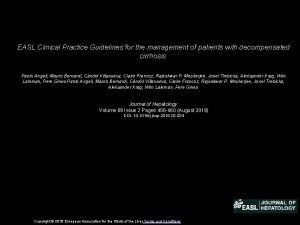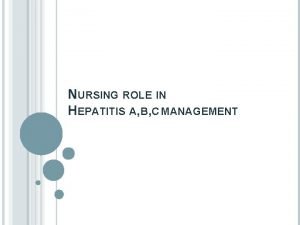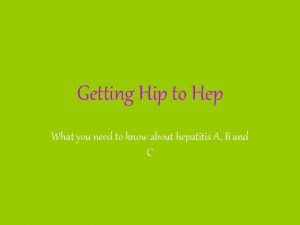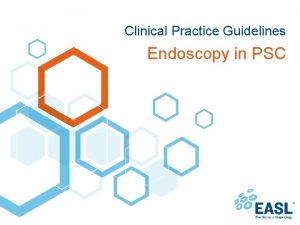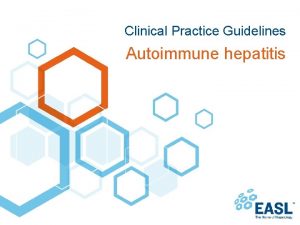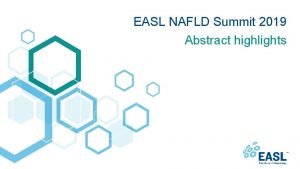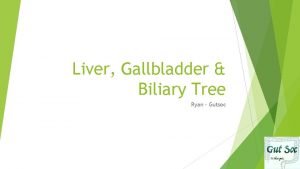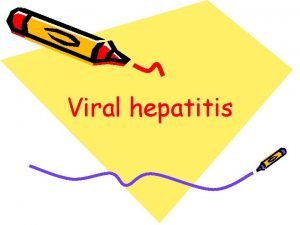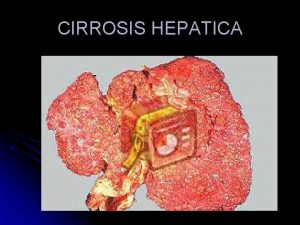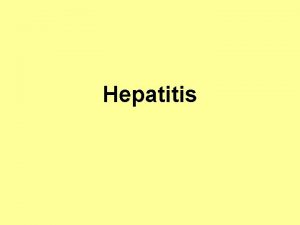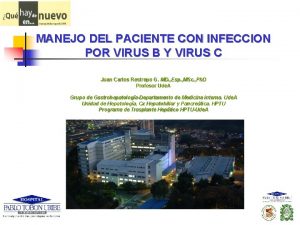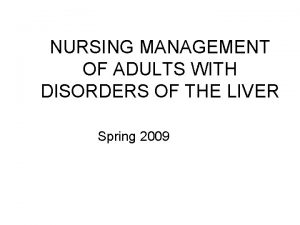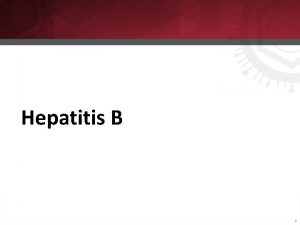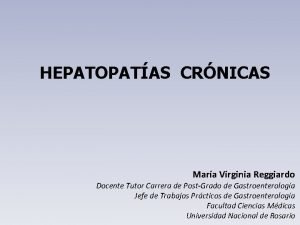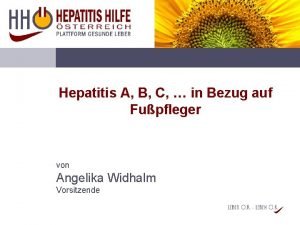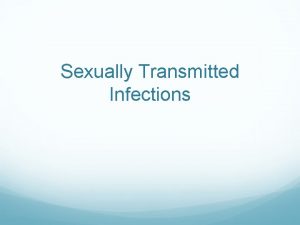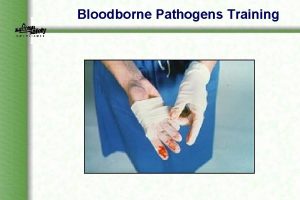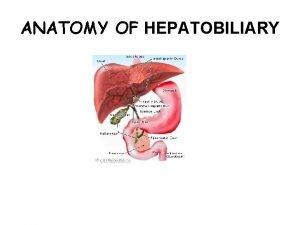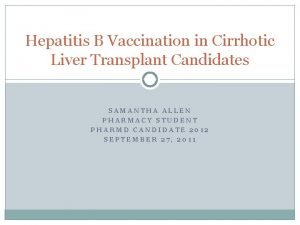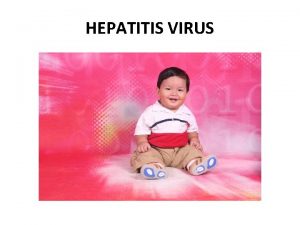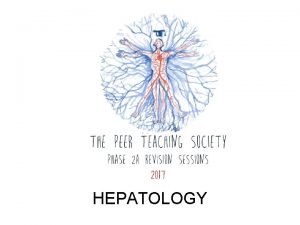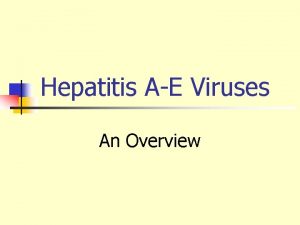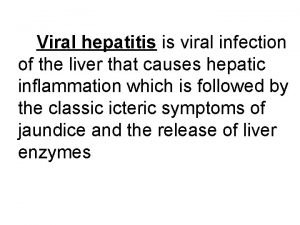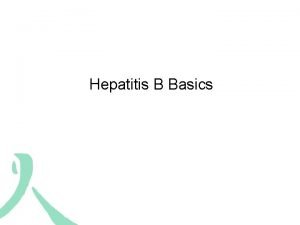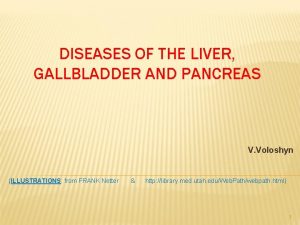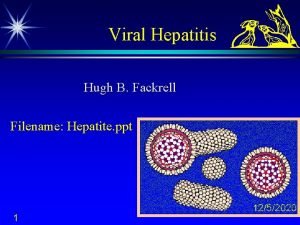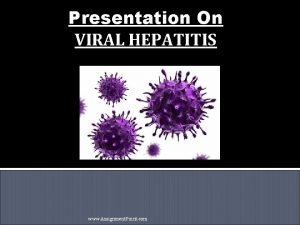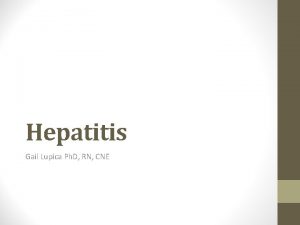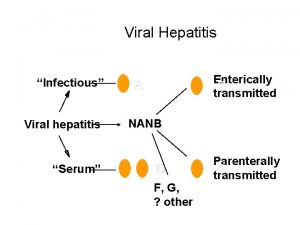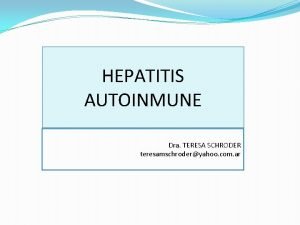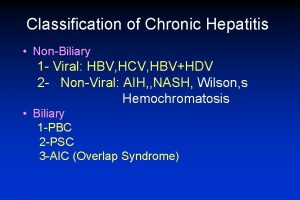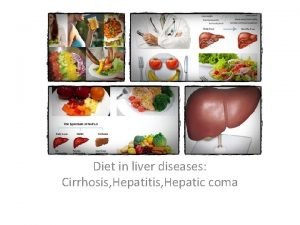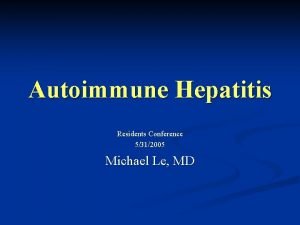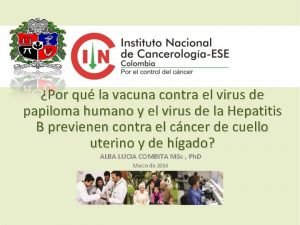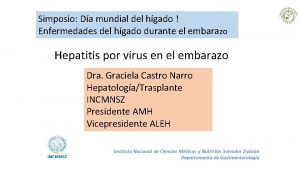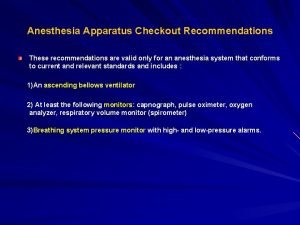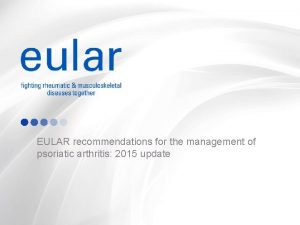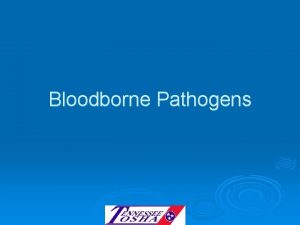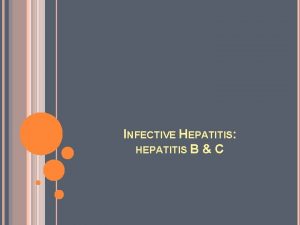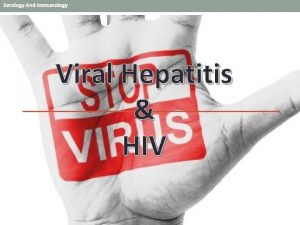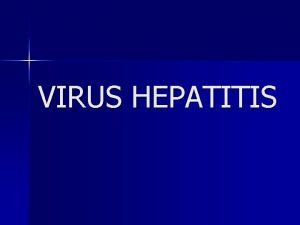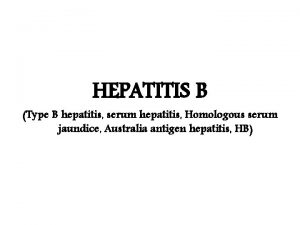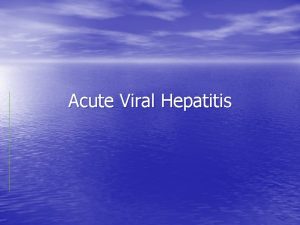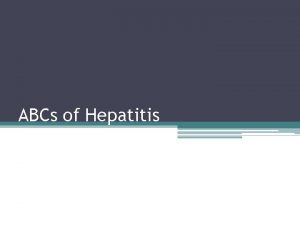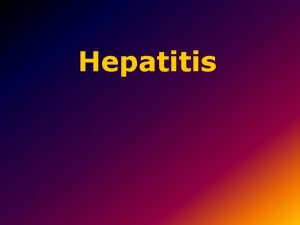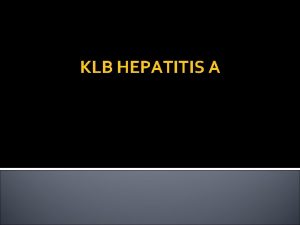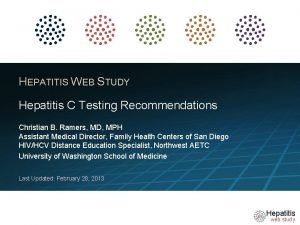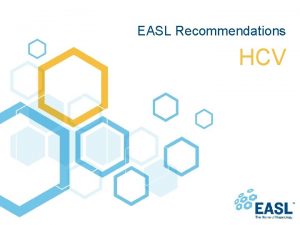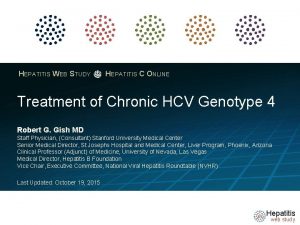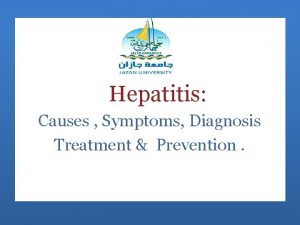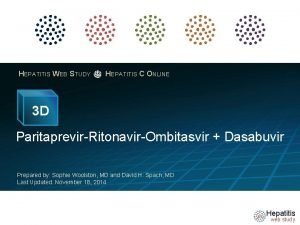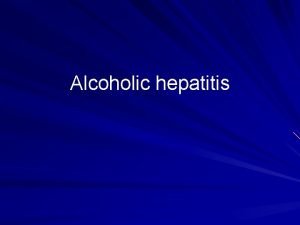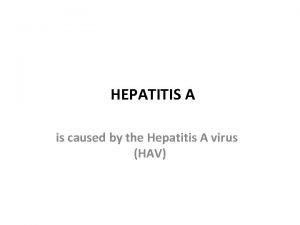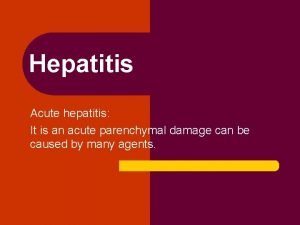EASL RECOMMENDATIONS ON TREATMENT OF HEPATITIS C 2018























































- Slides: 55


EASL RECOMMENDATIONS ON TREATMENT OF HEPATITIS C 2018 By Prof. Dr. Amr Aly Abdel Moety Head of Hepatobillary unit/Alex. university

Introduction • Hepatitis C virus (HCV) infection is one of the main causes of chronic liver disease world wide. The long-term natural history of HCV infection is highly variable. • The hepatic injury can range from minimal histological changes to extensive fibrosis and cirrhosis with or without hepatocellular carcinoma (HCC). • There approximately 71 million chronically infected individuals worldwide, many of whom are unaware of their infection, with important variations according to the geographical area. • Clinical care for patients with HCV-related liver disease has advanced considerably during the last two decades, thanks to an enhanced understanding of the pathophysiology of the disease, and because of developments in diagnostic procedures and improvements in therapy and prevention.

Introduction • The primary goal of HCV therapy is to cure the infection, i. e. to achieve a sustained virological response (SVR) defined as undetectable HCV RNA 12 weeks (SVR 12) or 24 weeks (SVR 24) after treatment completion. • An SVR corresponds to a cure of the HCV infection, with a very low chance of late relapse. • An SVR is generally associated with normalisation of liver enzymes and improvement or disappearance of liver necroinflammation and fibrosis in patients without cirrhosis. Patients with advanced fibrosis (METAVIR score F 3) or cirrhosis (F 4) remain at risk of life-threatening complications. • However, hepatic fibrosis may regress and the risk of complications such as hepatic failure and portal hypertension is reduced after an SVR.

Introduction • Recent data suggest that the risk of HCC and liver-related mortality is significantly reduced, but not eliminated, in patients with cirrhosis who clear HCV compared to untreated patients and non-sustained virological responders, especially in the presence of cofactors of liver morbidity, such as the metabolic syndrome, harmful alcohol consumption and/or concurrent hepatitis B virus (HBV) infection. • HCV is also associated with a number of extra-hepatic manifestations and viral elimination induces reversal of reduction of all-cause mortality. most of them with

Diagnosis of acute and chronic hepatitis C • The diagnosis of acute hepatitis C can only be made confidently if recent seroconversion to anti-HCV antibodies. • Clinical signs and symptoms are compatible with acute hepatitis (alanine aminotransferase [ALT] level >10 times the upper limit of normal, and/or jaundice). • If a likely recent source of transmission is identifiable. • HCVRNA can be detected during the acute phase, although their levels may vary widely and there may be interludes (up to several weeks) of undetectable HCV RNA.

Diagnosis of acute and chronic hepatitis C • Thus, HCV RNA-negative individuals should be retested for HCV RNA 12 and 24 weeks after a negative result to confirm definitive clearance. • In immune-compromised patients and in patients on haemodialysis, HCV RNA testing in serum or plasma should be part of the initial evaluation. • HCV reinfection can occur after spontaneous or treatment induced HCV clearance. Reinfection is defined by the reappearance of HCV RNA after an SVR. • The diagnosis of chronic hepatitis C is based on the detection of both anti-HCV antibodies and HCV RNA.

Goals and endpoints of HCV The goal of therapy is to cure HCV infection, in order to i. Prevent the complications of HCV-related liver and extra-hepatic diseases, including hepatic necroinflammation, fibrosis, cirrhosis, decompensation of cirrhosis, HCC, manifestations and death. ii. Improve quality of life and remove stigma. iii. Prevent onward transmission of HCV. severe extra-hepatic

Goals and endpoints of HCV The goal of therapy is to cure HCV infection, in order to • The endpoint of therapy is undetectable HCV RNA in serum or plasma by a sensitive assay (lower limit of detection ≤ 15 IU/ml) 12 weeks (SVR 12) or 24 weeks (SVR 24) after the end of treatment (A 1). • In patients with advanced fibrosis and cirrhosis, surveillance for HCC must be continued because an SVR will reduce, but not abolish, the risk of HCC (A 1).

• Pre-therapeutic The contribution ofassessment comorbidities to the progression of liver disease must be evaluated and appropriate corrective measures implemented. • Liver disease severity must be assessed prior to therapy. • Patients with cirrhosis must be identified, as their treatment regimen must be adjusted and post-treatment surveillance for HCC is mandatory. • Post-treatment surveillance for HCC must also be performed in patients with advanced fibrosis (METAVIR score F 3).

Non-invasive marker cut-offs for prediction of stages of fibrosis, including F 3 (advanced fibrosis) and F 4 (cirrhosis) Stage of Number of Test Cutoff AUROC Sensitivity Specificity PPV NPV Ref. fibrosis Fibor. Scan® F 3 F 4 ARFI (VTQ)® F 3 patients 560 HCV 10 KPaa positive 1. 855 HCV 13 KPaa positive 2. 691 (including 1. 601. 428 HCV 2. 17 m/ positive) s 2. 691 (including 2. 191. 428 HCV 2. 67 m/ positive) s 0. 83 72% 80% 62% 89% 42 0. 90 -0. 93 72 -77% 85 -90% 0. 94 84% 90% 4256% 9598% 42, 44, 47 (95% CI 0. 91 -0. 95) 0. 91 (95% CI 8088%) 86% (95% CI 8692%) 84% n. a. 46 (95% CI 0. 89 -0. 94) (95% CI 8091%) 90% (95% CI 8088%) 77% n. a. 46 F 4 Aixplorer® F 3 379 HCVPositive 9 KPaa 0. 91 (95% CI 7892%) 88% n. a. 45 F 4 379 HCVPositive (95% CI 72100%) 86% 13 KPaa 0. 93 (95% CI 7495%) (95% CI 7298%) n. a. 45 0. 74 0. 82 -0. 87 63 -71% 81 -84% 39 -40 9394 44, 47 1 -45 b 0. 87* 90% 58% 3. 258 b 1. 0 b (0. 83 -0. 92) 0. 84* 55% 77% 92% 75% n. a. 43 2. 0 b 0. 54 -0. 97) 48% 94% n. a. 43 Fibrotest® F 4 FIB-4 F 4 APRI F 4 1. 579 (including 1. 295 HCVpositive) 2. 297 HCVpositive 16. 694 HCVpositive

• Fibrosis stage must be assessed by non-invasive methods initially, with liver biopsy reserved for cases where there is uncertainty or potential additional aetiologies. • Renal function (creatinine/estimated glomerular filtration rate [e. GFR]) should be ascertained. • Extra-hepatic manifestations of HCV infection should be identified in case of symptoms. • HBV and HAV vaccination should be proposed to patients who are not protected.

• HCV genotype HCV RNA detection determination and quantification in serum or plasma should be made by a sensitive assay with a lower limit of detection of ≤ 15 IU/ml. • The HCV genotype and genotype 1 subtype (1 a or 1 b) must be assessed prior to treatment initiation to deter- mine the choice of therapy and its duration, among other parameters. • However, treatment with new pangenotypic regimens can be initiated without knowledge of the genotype and subtype in areas where genotype determination is not available and/ or not affordable, or to simplify treatment access. • Testing for HCV resistance prior to treatment is not recommended.

• Contraindications to therapy The use of certain cytochrome P 450 (CYP) /P- glycoprotein (P-gp) inducing agents such as carbamazepine (Tegretol) and phenytoin (antiseizures) are contraindicated with all regimens, due to the risk of significantly reduced concentrations of DAA. • Treatment regimens comprising a protease inhibitor must not be used in patients with Child-Pugh B or C decompensated cirrhosis or in patients with previous episodes of decompensation (A 1). • In patients with an e. GFR <30 ml/min/1. 73 m 2, sofosbuvir should only be used if no alternative treatment approved for use in patients with severe renal impairment is available.

Indications for treatment: who should be treated? 1. All patients with HCV infection must be considered for therapy. 2. Treatment should be considered without delay in patients with significant fibrosis or cirrhosis (METAVIR score F 2, F 3 or F 4), including compensated (Child-Pugh A) and decompensated (Child-Pugh B or C) cirrhosis. 3. Patients with clinically significant extra-hepatic manifestations (e. g. symptomatic vasculitis associated with HCV-related mixed cryoglobulinaemia, HCV immune complex-related nephropathy and non. Hodgkin B-cell lymphoma). 4. Patients with HCV recurrence after liver transplantation. 5. Patients at risk of a rapid evolution of liver disease because of concurrent comorbidities (non-liver solid organ or stem cell transplant recipients, HBV coinfection, diabetes).

Indications for treatment: who should be treated? 6. Patients transmitting HCV (PWID), men who have sex with men with high-risk sexual practices, women of childbearing age who wish to get pregnant, haemodialysis patients, incarcerated individuals. 7. Patients with decompensated (Child-Pugh B or C) cirrhosis and an indication for liver transplantation with a MELD score ≥ 18– 20 should be transplanted first and treated after transplantation. 8. If the waiting time on a liver transplant list is more than 6 months, patients with decompensated (Child-Pugh B or C) cirrhosis with a MELD score ≥ 18– 20 can be treated before transplantation, although the clinical benefit for these patients is not well established. 9. Treatment is generally not recommended in patients with limited life expectancy due to non-liver-related comorbidities.

Available drugs in Europe in 2018 HCV DAAs approved in Europe in 2018 and recommended in this document Product Presentation Posology Pangenotypic drugs or drug combinations Sofosbuvir/velpatasvir (EPCLUSA) Sofosbuvir/velpatasvir/ Voxilaprevir (VOSEVI) Glecaprevir/pibrentasvir (MAVYRET) Tablets containing 400 mg of sofosbuvir and 100 mg of velpatasvir Tablets containing 400 mg of sofosbuvir, 100 mg of velpatasvir and 100 mg of voxilaprevir Tablets containing 100 mg of glecaprevir and 40 mg of pibrentasvir One tablet once daily Three tablets once daily Genotype-specific drugs or drug combinations Sofosbuvir/ledipasvir (HARVONI) Paritaprevir/ombitasvir/ Ritonavir (QUREVO) Dasabuvir (EXVIERA) Grazoprevir/elbasvir (ZEPATIER) Tablets containing 400 mg of sofosbuvir and 90 mg of ledipasvir Tablets containing 75 mg of paritaprevir, 12. 5 mg of ombitasvir and 50 mg of ritonavir One tablet once daily Two tablets once daily Tablets containing 250 mg of dasabuvir One tablet twice daily (morning and evening) Tablets containing 100 mg of grazoprevir and 50 mg of elbasvir One tablet once daily

DRUG INTERACTIONS 1. Drug-drug interactions between HCV DAAs and antiretroviral drugs(HIV/AIDS)

DRUG INTERACTIONS 2. Drug-drug interactions between HCV DAAs and illicit/recreational drugs or drugs of abuse

DRUG INTERACTIONS 3. Drug-drug interactions between HCV DAAs and lipid lowering drugs

DRUG INTERACTIONS 4. Drug-drug interactions between HCV DAAs and central nervous system drugs

DRUG INTERACTIONS 5. Drug-drug interactions between HCV DAAs and cardiovascular drugs

DRUG INTERACTIONS 6. Drug-drug interactions between HCV DAAs and immunosuppressants

DRUG INTERACTIONS 7. Drug-drug interactions between HCV DAAs and antiplatelets and anticoagulants

DRUG INTERACTIONS 8. Dose equivalence among proton pump inhibitors and H 2 antagonists Drug family Drug Dose Proton pump inhibitors Omeprazole (dose equivalent to omeprazole Lansoprazole 20 mg once daily) Esomeprazole Pantoprazole Rabeprazole 20 mg once daily 30 mg once daily 20 mg once daily 40 mg once daily 20 mg once daily H 2 antagonists Famotidine (dose equivalent to famotidine Ranitidine 20 mg twice daily) Cimetidine 20 mg twice daily 150 mg twice daily 300 mg three-four times daily 150 mg twice daily Nizatidine DDAs should be taken 4 hours before the proton pump inhibitor if possible

Treatment of chronic hepatitis C, including patients without cirrhosis and patients with compensated (Child. Treatment-naïve and treatment-experienced patients. A) without cirrhosis or with compensated (Child-Pugh A) cirrhosis, Pugh cirrhosis recommended for each HCV genotype/subtype in 2018 and onwards

Treatment of chronic hepatitis C, including patients without cirrhosis and patients with compensated (Child. Treatment recommendations for HCVPugh with chronic without cirrhosis, including treatment-naïve A) hepatitis cirrhosis patients and treatment-experienced patients

Treatment of chronic hepatitis C, including patients without cirrhosis and patients with compensated (Child. Treatment recommendations for HCV-monoinfected or HCV/HIV-coinfected patients with chronic Pugh A) cirrhosis hepatitis C with compensated (Child-Pugh A) cirrhosis

Treatment of HCV genotype 4 infection • Four treatment options are available in 2018 for patients infected with HCV genotype 4: 1. Sofosbuvir/velpatasvir. 2. Glecaprevir/pibrentasvir. 3. Sofosbuvir/ledipasvir. 4. Grazoprevir/elbasvir.

Genotype 4, Pangenotypic: Sofosbuvir/velpatasvir • Treatment-naïve and treatment-experienced patients infected with HCV genotype 4, without cirrhosis or with compensated (Child-Pugh A) cirrhosis. (ASTRAL-1 trial showing SVR 12 in 100% (116/116) of patients).

Genotype 4, Pangenotypic: Glecaprevir/pibrentasvir • Treatment-naïve and treatment-experienced patients infected with HCV genotype 4 without cirrhosis should be treated with the fixed-dose combination of glecaprevir and pibrentasvir for 8 weeks (SURVEYOR-2 trial showing an SVR 12 rate of 93%). • Patients with cirrhosis treatment for 12 weeks. (EXPEDITION-1, 100% (16/16) of patients with cirrhosis infected with genotype 4 achieved SVR 12. )

Genotype 4, Genotype-specific: Sofosbuvir/ledipasvir • Treatment-naïve patients infected with HCV genotype 4, without cirrhosis or with compensated (Child-Pugh A) cirrhosis, should be treated with the fixed-dose combination of sofosbuvir and ledipasvir for 12 weeks. The SYNERGY trial 95% achieved an SVR. • The combination of sofosbuvir and ledipasvir is not recommended in treatment-experienced patients infected with genotype 4.

Genotype 4, Genotype-specific: Grazoprevir/elbasvir • Treatment-naïve patients infected with genotype 4, without cirrhosis or with compensated (Child-Pugh A) cirrhosis, with an HCV RNA level ≤ 800, 000 IU/ml at baseline should be treated with the fixed-dose combination of grazoprevir and elbasvir for 12 weeks (CEDGE-TN trial, the SVR 12 rate was 100%. • The combination is not recommended treatment-naïve with an HCV RNA level >800, 000 IU/ml, or treatmentexperienced regardless of their baseline HCV RNA level.

Simplified treatment of chronic hepatitis C with pangenotypic drug regimens in patients without cirrhosis and in patients with compensated (Child. Pugh A) cirrhosis • Simplified, pangenotypic anti-HCV treatment recommendations are now possible, thanks to the approval of highly efficacious, safe and well-tolerated pangenotypic anti-HCV drug regimens. • Pre-treatment assessment can be limited to proof of HCV replication (presence of HCV RNA), the presence or absence of cirrhosis by means of a simple non-invasive marker (such as FIB-4 or APRI) that determines whether the patient needs post-treatment follow-up. • Treatment-naïve and treatment-experienced patients without cirrhosis or with compensated (Child-Pugh A) cirrhosis can be treated with either the fixed-dose com- bination of sofosbuvir and velpatasvir for 12 weeks, or the fixed-dose combination of glecaprevir and pibrentasvir for 12 weeks without testing genotype.

Simplified treatment of chronic hepatitis C with pangenotypic drug regimens in patients without cirrhosis and in patients with compensated (Child. Pugh A) cirrhosis • If cirrhosis can be reliably excluded by means of a non- invasive marker in treatment-naïve patients, the combination of glecaprevir and pibrentasvir can be administered for 8 weeks only. • Generic drugs can be used, provided that quality controls are met and guaranteed by the provider. • Possible drug-drug interactions should be carefully checked and dose modifications implemented when necessary. • Given the high SVR 12 rates expected with these regimens across all groups of patients if adherent, checking SVR 12 12 weeks after the end of treatment is dispensable. • Patients with high-risk behaviours and risk of reinfection should be tested for SVR 12 and yearly thereafter whenever possible. • In patients with advanced fibrosis (F 3) or compensated cirrhosis (F 4), post. SVR surveillance for the diagnosis of HCC.

Treatment of patients with severe liver disease with or without an indication for liver transplantation and patients in the post-liver transplant setting • IFN-free, DAA-based regimens are the most suitable options for patients with decompensated (Child-Pugh B or C) liver disease. • Protease inhibitors are contraindicated for this group.

Patients with decompensated cirrhosis, no HCC, with an indication for liver transplantation • Patients with decompensated (Child-Pugh B or C) cirrhosis should be treated in experienced centres with easy access to liver transplantation and close monitoring during therapy is required, with the possibility of stopping therapy with evidence of worsening decompensation during treatment. • Patients with decompensated (Child-Pugh B or C) cirrhosis, without HCC, awaiting liver transplantation with a MELD score <18– 20 should be treated prior to liver transplantation. • Protease inhibitors-containing regimens are contraindicated in patients with decompensated (Child-Pugh B or C) cirrhosis. • Patients with decompensated (Child-Pugh B or C) cirrhosis, without HCC, awaiting liver transplantation with a MELD score <18– 20 can be treated with sofosbuvir and ledipasvir (genotypes 1, 4, 5 and 6), or with sofosbuvir and velpatasvir (all genotypes), with daily weight-based ribavirin (1, 000 or 1, 200 mg in patients <75 kg or ≥ 75 kg, respectively) for 12 weeks.

Patients with decompensated cirrhosis, no HCC, with an indication for liver transplantation • Patients with decompensated (Child-Pugh B or C) cirrhosis with contraindications to the use of ribavirin or with poor tolerance to ribavirin on treatment should receive the fixed-dose combination of sofosbuvir and ledipasvir (genotypes 1, 4, 5 or 6), or the fixed-dose combination of sofosbuvir and velpatasvir (all genotypes), for 24 weeks without ribavirin. • Patients with decompensated cirrhosis without HCC awaiting liver transplantation with a MELD score ≥ 18– 20 should be transplanted first, without antiviral treatment. • HCV infection should be treated after liver trans- plantation. • Patients with decompensated cirrhosis without HCC awaiting liver transplantation with a MELD score ≥ 18– 20 can be treated before transplantation if the waiting time on the transplant list exceeds 6 months, depending on the local situation.

Patients with HCC, without cirrhosis or with compensated cirrhosis, with an indication for liver transplantation • Antiviral treatment can be initiated before liver transplantation to prevent recurrence of infection and post- transplant complications, provided that it does not interfere with the management of the patient on the waiting list • Antiviral treatment can be delayed until after transplantation, with a high likelihood of SVR.

• Post-liver transplantation recurrence All patients with post-transplant recurrence of HCV infection should be considered for therapy generally after the first 3 months post-transplant. • Fibrosing cholestatic hepatitis indicate urgent antiviral treatment because they predict rapid disease progression and graft loss • Immunosuppressant drug levels during and after anti- HCV therapy must be monitored • Patients with post-transplant recurrence of HCV genotype 1, 4, 5 or 6 infection, treated with the fixed-dose combination of sofosbuvir and ledi-pasvir or the fixed-dose combination of sofosbuvir and velpatasvir for 12 weeks.

• Post-liver transplantation recurrence Patients with post-transplant recurrence of HCV geno-type 2 or 3, without cirrhosis or with compensated (Child-Pugh A) cirrhosis, should be treated with the fixed-dose combination of sofosbuvir and velpatasvir for 12 weeks. • Patients with post-transplant recurrence of all HCV genotypes, without cirrhosis or with compensated (Child- Pugh A) cirrhosis, with an e. GFR <30 ml/min can be treated with the fixed-dose combination of glecaprevir and pibrentasvir for 12 weeks. • Patients with post-transplant HCV recurrence with decompensated (Child-Pugh B or C) cirrhosis should be treated with sofosbuvir and ledipasvir (genotypes 1, 4, 5 or 6), or sofosbuvir and velpatasvir (all genotypes), for 12 weeks with daily weight-based ribavirin Or 24 weeks without ribavirin.

Patients with decompensated cirrhosis without an indication for liver transplantation • Patients with decompensated (Child-Pugh B and Child. Pugh C up to 12 points) cirrhosis should be treated urgently. Protease inhibitors-containing regimens are contraindicated. • Treatment regimen: Ø Sofosbuvir and ledipasvir (genotypes 1, 4, 5 or 6) OR sofosbuvir and velpatasvir (all genotypes) Plus Ribavirin for 12 w without ribavirin for 24 weeks.

Patients with treated HCC without an indication for liver transplantation • HCV treatment should not be withheld in patients with cirrhosis and these patients will require post. SVR HCC surveillance, because the risk of de novo or incident HCC is reduced but not abolished by SVR.

Treatment of special groups HBV coinfection • Patients with HBV-HCV coinfection should be treated with the same anti-HCV regimens, following the same rules as HCV monoinfected patients. • Patients coinfected with HCV and HBV fulfilling the standard criteria for HBV treatment should receive nucleoside/nucleotide analogue treatment according to the EASL 2017 Clinical Practice Guidelines on the management of hepatitis B virus infection.

Treatment of special groups HBV coinfection • Patients who are HBs antigen-positive should receive nucleoside/nucleotide analogue prophylaxis at least until week 12 post anti-HCV therapy and be monitored monthly if HBV treatment is stopped. • In patients who are HBs antigen-negative but anti-HBc antibodypositive, serum ALT levels should be monitored monthly, HBs antigen and HBV DNA should be tested if ALT levels do not normalise or rise during or after anti-HCV therapy.

Immune complex-mediated manifestations of chronic hepatitis • Mixed cryoglobulinemia and. Crenal disease associated with chronic HCV infection must be treated with IFN- free, ribavirinfree DAA-based anti-HCV combinations, according to the above recommendations. Careful monitoring for adverse events is mandatory (B 1). • The indication for rituximab in HCV-related renal disease must be discussed by a multidisciplinary team. • HCV-associated lymphoma should be treated with IFN- free, ribavirin-free regimens according to the above recommendations, in combination with specific chemotherapy, taking into account possible drug-drug interactions.

Patients with renal impairment, including haemodialysis patients • Patients with HCV infection and mild to moderate renal impairment (e. GFR ≥ 30 ml/min/1. 73 m 2) should be treated according to the general recommendations. No dose adjustments of HCV DAAs are needed, but these patients should be carefully monitored. • Patients with severe renal impairment (e. GFR <30 ml/ min/1. 73 m 2) and patients with end-stage renal disease on haemodialysis should be treated in expert centres, with close monitoring by a multidisciplinary team

Patients with renal impairment, including haemodialysis patients • Sofosbuvir should be used with caution in patients with an e. GFR <30 ml/min/1. 73 m 2 or with end-stage renal disease, only if an alternative treatment is not available. • Patients infected with all genotypes with severe renal impairment (e. GFR <30 ml/min/1. 73 m 2), or with end- stage renal disease on haemodialysis, without an indication for kidney transplantation, should be treated with the fixed-dose combination of glecaprevir and pibrentasvir for 8 or 12 weeks, according to the general recommendations.

Haemoglobinopathies and bleeding disorders • The indications for HCV therapy are the same in patients with and without haemoglobinopathies or bleeding disorders.

Adolescents and children • Adolescents aged 12 years and above infected with genotype 1, 4, 5 or 6 who are treatment - naïve or treatment - experienced, without cirrhosis or with compensated (Child-Pugh A) cirrhosis, should be treated with the fixed-dose combination of sofosbuvir (400 mg) and ledipasvir (90 mg) for 12 weeks. • Adolescents aged 12 years and above infected with genotype 2 or 3 who are treatment-naïve or treatment- experienced, without cirrhosis or with compensated (Child-Pugh A) cirrhosis, can be treated with other regimens approved for adults, with caution pending more safety data in this population. • In children younger than 12 years, treatment should be deferred until DAAs, including pangenotypic regimens, are approved for this age group.

Retreatment of non-sustained virological responders • Patients who failed treatment must be retreated according to the above recommendations for ‘‘treatment-experienced” patients, by HCV genotype. • HCV resistance testing prior to retreatment is useful to guide retreatment. • Can be retreated with the fixed-dose combination of sofosbuvir, velpatasvir and voxilaprevir for 12 weeks. • OR sofosbuvir plus the fixed-dose combination of glecaprevir and pibrentasvir for 12 weeks

In very difficult-to-cure patients • The combination of sofosbuvir, velpatasvir and voxilaprevir, or the triple combination of sofosbuvir, glecaprevir and pibrentasvir can be administered for 12 weeks with weight-based ribavirin and/or treatment duration can be prolonged to 16 to 24 weeks. • Patients with decompensated (Child-Pugh B or C) cirrhosis should be retreated with the fixed-dose combination of sofosbuvir and velpatasvir with ribavirin for 24 weeks.

Treatment of acute hepatitis C • Patients with acute hepatitis C should be treated with a combination of sofosbuvir and ledipasvir (genotypes 1, 4, 5 and 6) or a combination of ritonavir-boosted paritaprevir, ombitasvir and dasabuvir (genotype 1 b) for 8 weeks. • OR combination of sofosbuvir and velpatasvir OR glecaprevir and pibrentasvir for (all genotypes) for 8 weeks. • SVR should be assessed at 12 and 24 weeks posttreatment, because late relapses have been reported.

Post-treatment follow-up of patients who achieve an SVR • Patients with no to moderate fibrosis (METAVIR score F 0 -F 2), with SVR and no ongoing risk behavior should be discharged, provided that they have no other comorbidities. • Patients with advanced fibrosis (F 3) or cirrhosis (F 4) with SVR should undergo surveillance for HCC every 6 months by means of ultrasound. • In patients with cirrhosis, surveillance for oesophageal varices. • Following SVR, monitoring for HCV reinfection ideally at least annual HCV RNA assessment should be undertaken in PWIDs or men who have sex with men with ongoing risk behavior.

u o y k n a Th
 Easl 2018 guidelines
Easl 2018 guidelines Hep c symptoms female
Hep c symptoms female Question one piece
Question one piece Easl guidelines psc
Easl guidelines psc Easl guidelines aih
Easl guidelines aih Easl slide deck
Easl slide deck Nafld summit
Nafld summit Dada la siguiente secuencia rusia 2018 rusia 2018
Dada la siguiente secuencia rusia 2018 rusia 2018 Hepatitis b panel
Hepatitis b panel Bare area liver
Bare area liver Ano ang pagkakaiba ng hepatitis a at b
Ano ang pagkakaiba ng hepatitis a at b Neonatal jaundice
Neonatal jaundice Window period of hepatitis b
Window period of hepatitis b Fotos de colestasis del embarazo
Fotos de colestasis del embarazo Corticoides hepatitis alcoholica
Corticoides hepatitis alcoholica Causes of chronic hepatitis
Causes of chronic hepatitis Hepatitis b cronica
Hepatitis b cronica Hepatitis f y g
Hepatitis f y g Esophageal varices nursing management
Esophageal varices nursing management Hbv
Hbv Circulacion hiperdinamica
Circulacion hiperdinamica Hepatitis
Hepatitis Symptoms of gonorrhea
Symptoms of gonorrhea Hepatitis c symptoms in men
Hepatitis c symptoms in men Porta hepatis
Porta hepatis Hep b vaccine schedule for adults
Hep b vaccine schedule for adults Klasifikasi hepatitis a
Klasifikasi hepatitis a Pbc vs psc
Pbc vs psc Chronic hepatitis
Chronic hepatitis Achrolic
Achrolic Chronic pancreatitis nursing care plan
Chronic pancreatitis nursing care plan Hepatitis b
Hepatitis b Alcoholic hepatitis
Alcoholic hepatitis Hepatitis types chart
Hepatitis types chart Oral sex
Oral sex Infectious canine hepatitis in dogs
Infectious canine hepatitis in dogs Hepatitis d
Hepatitis d Gail lupica
Gail lupica Infectious canine hepatitis in dogs
Infectious canine hepatitis in dogs Hepatitis e
Hepatitis e Score simplificado hepatitis autoinmune
Score simplificado hepatitis autoinmune Classification of chronic hepatitis
Classification of chronic hepatitis Hepatic coma diet
Hepatic coma diet Michael le md
Michael le md Vacuna hepatitis b dosis
Vacuna hepatitis b dosis Hepatitis viral
Hepatitis viral Anesthesia delivery system testing
Anesthesia delivery system testing Gossec
Gossec Nap 6 summary
Nap 6 summary Npe 1986 12 parts
Npe 1986 12 parts Giving opinions en español
Giving opinions en español How to make ipcr
How to make ipcr Main objectives of kothari commission
Main objectives of kothari commission What was the purpose of appointing mudaliar commission
What was the purpose of appointing mudaliar commission L.m. singhvi committee in tamil
L.m. singhvi committee in tamil Clickmap omniture
Clickmap omniture
